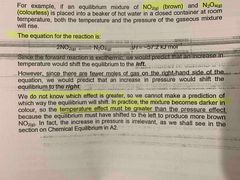![]()
![]()
![]()
Use LEFT and RIGHT arrow keys to navigate between flashcards;
Use UP and DOWN arrow keys to flip the card;
H to show hint;
A reads text to speech;
17 Cards in this Set
- Front
- Back
|
Advantages of catalysts |
Increase rate of reaction, more product made in less time - lower production costs - less co2 produced - higher atom economy |
|
|
Dynamic equilibrium features |
- the rate of the forward and backward reactions are equal - the concentration of the reactants and products are constant. - Both reactions occur continuously |
|
|
What are the conditions required for dynamic equilibrium? |
- Reaction must be reversible - Reaction must be in a closed container. |
|
|
What factors affect the position of equilibrium? |
- Concentration of a component - temperature of the system - pressure of a system - catalyst ( speeds up both reactions, no effect on position. Reduces the time required to establish equilibrium) |
|
|
Effect of conc. Increase on equilibrium |
- increased conc. of reactants shifts equilibrium to the right and vice versa.. - increased conc of products shifts eq. to the left and vise versa.. |
|
|
Effect of pressure change |
Only applies to reactions involving gases. - increasing pressure of system shifts to the side with less gas moles. - if the number of moles of both reactants and products is equal the pressure change has no effect of the position. |
|
|
Effect of temp. Change |
- Increase T: favours the endothermic reaction - Decrease T: favours the exithermic reaction. |
|
|
The effect of change in T and P on the equilibrium system between N2O4 and NO2 |

Back (Definition) |
|
|
Why is a temperature and pressure (450 and 250atm) used in the Haber process? F.reaction is exo, and higher pressure increases yield |
- Iron catalyst does not function efficiently at low temps. - A very high temp would be too expensive and can decrease yield. - A very high pressure would also be expensive - 450 degrees and 250 atm are compromised. |
|
|
T:9 alcohols - Distinguish between primary, secondary and tertiary alcohols |
Primary - Carbon bonded to -OH group is also bonded to only one other carbon atom. Secondary - Carbon bonded to -OH group is also bonded to two other carbon atoms Tertiary - Carbon bonded to -OH group is also bonded to three other carbon atoms |
|
|
Reaction of alcohol with oxygen gives what products |
carbon dioxide and water (combustion) |
|
|
How do you convert alcohols into chloroalkanes? |
React with PCl5 ( phosphorus pentachloride / phosphorus (V) chloride. - Two inorganic products produced in addition to the chloroalkane which are: 1 - POCl3 ( phosphorus oxychloride) 2 - HCl ( Hydrogen chloride) alcohol + PCl5 -> chloroalkane + POCl3 + HCl |
|
|
How to convert tertiary alcohols into chloroalkanes |
Mix with concentrated HCl at room temperature. - Produces the chloroalkane and water T.alcohol+HCl -> chloroalkane+ H2O |
|
|
Production of bromoalkanes from alcohols |
Warm alcohol with mixture of 50% potassium bromide (KBr)and 50% concentrated sulfuric acid. - other inorganic product is either KSO4 or KHSO4 Equations: 1) KBr + H2SO4 -> KHSO4 + HBr 2) alcohol + HBr -> bromoalkane + H2O |
|
|
Production of iodoalkanes from alcohols |
Heat under reflux the alcohol and the mixture of iodine and red phosphorus. - Inorganic product: Phosphonic acid H3PO3 - Firstly, PI3 is produced, then it reacts with the alcohol to produce the iodoalkane. Equations: 1) 2P + 3I2 -> 2PI3 2) alcohol + PI3 -> 3 iodoalkane + H3PO3 |
|
|
State all the halogenating agents of alcohols |
chloeoalkanes: PCl5 ( and HCl) - bromoalkanes: potassium bromide and conc.H2SO4 (50/50 mixture) - iodoalkanes: red phosphorus and iodine mixture |
|
|
How to form alkenes from alcohols |
By elimination reaction - react with concentrated phosphoric acid ( H3PO4 ). - water is also produced, which mixes with the acid to dilute it. - the OH group and an H atom are removed to form H2O. - sometimes more than one isomer of the alkene can form |

